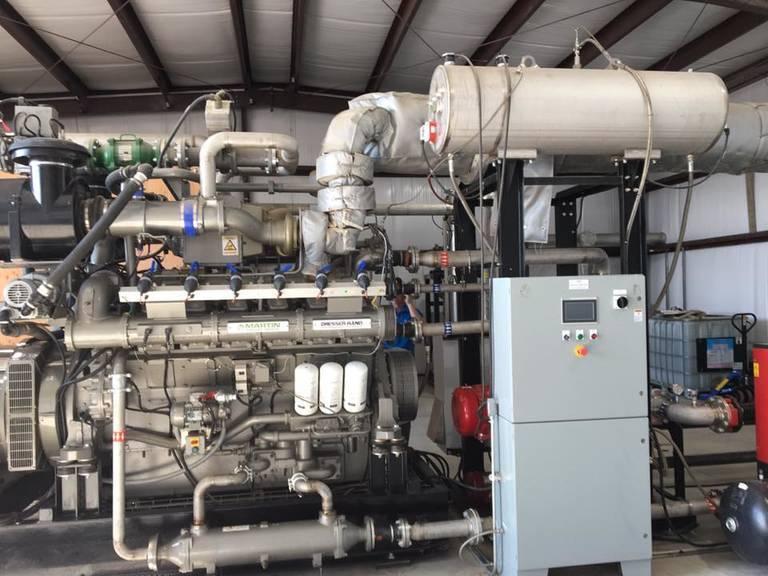
Last Friday, several dozen farmers, government officials, dairy industry representatives and clean energy professionals met at Philip Verwey Farms in rural Madera County, 160 miles southeast of San Francisco. They congregated near where 5,600 dairy cows contribute to the region’s growing dairy industry – as well as the state's greenhouse gas emissions.
The ceremony at this dairy on Road 9, halfway between the small towns of Firebaugh and Chowchilla, marked the launch of an anaerobic digester, a technology that more industry leaders and policymakers say can help the dairy sector reduce its emissions. Last year, California’s approximately 1.4 million dairy cows fell under a statewide mandate to find a way to curb their environmental footprint in order to achieve the state’s goal to reduce methane emissions 40 percent from 2013 levels by 2030.
Dairy farmers are responding in kind: California’s state government says it is receiving more applications for projects than it can currently fund.
Maas Energy Works, the lead contractor for this anaerobic digester, certainly believes projects like this one in Madera County can make a difference. The company claims that the cows roaming on this property expel enough manure to power a 600 kW generator that produces 250,000 kWh of electricity a month. That is enough power to electrify this dairy farm’s operations, equal to the power needs of 300 homes. The company says it will reduce this farm’s emissions by 240,000 metric tons of carbon, which is equivalent to eliminating 5,000 cars from the road each year.
The process starts as the cows expel manure in the yards in which they roam, an area that is sloped so the collection of manure occurs more seamlessly while the cows are easily kept clean. A separator removes the solids, which are eventually dried and kept for those cows’ bedding. The liquids then circulate to a pond, and gasses are diverted to the nearby digester, which according to a Maas Energy representative, measures about 150 feet long by 400 feet wide and 25 feet deep.
That digester is lined on the ground so nothing can seep into the ground; a fabric tap above traps the gas so it does not escape into the air. (It can preoccupy the farm’s guests, as it can function almost as a trampoline). As a Maas Energy representative explained, “It acts just like a cow’s stomach” – and appears like a giant-sized version of one, too.
Organizers of this event said the digester can hold a two- to three- day supply of this gas, and can disperse up to 170 cubic feet of gas per minute.
A catalytic system then treats the gas and removes pollutants such as sulfur; that clean gas is then piped to a shed, where the farm’s new generator is housed, and then generates power for the dairy. Maas Energy says it has a plan to expand the generator’s capacity to 800 kW, which would allow Philp Verwey Farms to actually sell power locally in an arrangement with PG&E.
Funds for the project provided partly by the California Department of Food and Agriculture (CDFA). As part of legislation passed last fall, the CDFA received $50 million in funds to work with dairy farmers and livestock operators to find ways to eliminate methane emissions. About $14 million of those funds will be used for incentives within what the state calls its Alternative Manure Management Program.
The rest of the funds, about $36 million, are slated for digester programs similar to this one in Madera County. According to Jenny Lester Moffitt, Deputy Secretary of CDFA and one of the speakers at Friday’s event, competition is fierce: the agency could have funded over $70 million in grants based on the applications they received. Currently the CDFA will offer a maximum of $3 million per project: the dairy operator has to provide 50 percent of a manure-to-energy project’s overall costs.
The U.S. Department of Agriculture (USDA) and PG&E also contributed funds for the anaerobic digester system; none of the parties would disclose their exact contribution to this project.
Similar projects have launched in Kings and Tulare County, the latter of which is home to the largest dairy industry in the U.S. A similar digester project green-lighted in 2015, located near the town of Pixley, aims to become part of a network of 10 dairy farm manure-to-energy projects that would provide renewable power in the local area.
Image credits: Leon Kaye

Leon Kaye has written for 3p since 2010 and become executive editor in 2018. His previous work includes writing for the Guardian as well as other online and print publications. In addition, he's worked in sales executive roles within technology and financial research companies, as well as for a public relations firm, for which he consulted with one of the globe’s leading sustainability initiatives. Currently living in Central California, he’s traveled to 70-plus countries and has lived and worked in South Korea, the United Arab Emirates and Uruguay.
Leon’s an alum of Fresno State, the University of Maryland, Baltimore County and the University of Southern California's Marshall Business School. He enjoys traveling abroad as well as exploring California’s Central Coast and the Sierra Nevadas.














